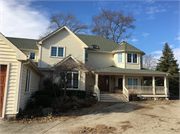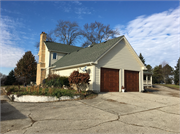Property Record
935 172ND AVENUE (CTH D)
Architecture and History Inventory
| Historic Name: | House, Mike Hensgen Farmstead |
|---|---|
| Other Name: | |
| Contributing: | |
| Reference Number: | 240900 |
| Location (Address): | 935 172ND AVENUE (CTH D) |
|---|---|
| County: | Kenosha |
| City: | |
| Township/Village: | Paris |
| Unincorporated Community: | |
| Town: | 2 |
| Range: | 21 |
| Direction: | E |
| Section: | 9 |
| Quarter Section: | SE |
| Quarter/Quarter Section: | NE |
| Year Built: | 1925 |
|---|---|
| Additions: | C. 1995 |
| Survey Date: | 2019 |
| Historic Use: | house |
| Architectural Style: | Cross Gabled |
| Structural System: | |
| Wall Material: | Composition Board |
| Architect: | |
| Other Buildings On Site: | Y |
| Demolished?: | No |
| Demolished Date: |
| National/State Register Listing Name: | Not listed |
|---|---|
| National Register Listing Date: | |
| State Register Listing Date: |
| Additional Information: | This farmstead stands at 935 172nd Avenue (CR D). It straddles two sections, with the house set on the NE-SE quarter of Section 9, while the farm buildings stand nearby in the NW-SW quarter of Section 10. The property is comprised of eleven historic resources. A large modern commercial horse stable is located south of the complex was not inventoried; it was built in 1995 and stands outside the historic farmstead boundaries. The two-story house was constructed in 1925. The side-gable east elevation is the primary façade. The house lost integrity with large additions in 1995-2000. Historic aerial imagery indicates the original footprint was rectangular with a cross-gable roof. The house is obscured by trees in 1937, but it was clearly defined in the 1963 photo. The building underwent few changes until 1995-2000 when the large gabled garage bay was added the south end of the front wall. A rounded wraparound porch was built at the northeast corner of the house, along with a two-story window bay with conical roof. The original front-gabled bay was likely altered at this time with a one-story projecting dormer bay. The roofs are asphalt shingle and a brick chimney stands on either end of the building. The hardboard lap siding, windows, and doors throughout the house are modern replacements. Paris plat maps indicate this farmstead has historically straddled the line between Sections 9 and 10. In 1861, the two parcels were owned by J. Hanskin, with the homestead on 30 acres in Section 9 and 60 acres in Section 10. That name is likely a misprint of the name J. Hensgen, who owned both parcels in 1873, totaling 170 acres. The homestead was indicated in Section 10 in 1861, but had been moved to its present location by 1873. His farm grew by 1887 to include a 146-acre parcel in Section 15; by 1899, 90 more acres were added in Section 9 (formerly owned by a son Michael (M.) Hensgen. Between 1899 and 1908, several of the Hensgen parcels changed ownership, likely a result of generational exchanges: J. Hensgen Sr owned this 170-acre farmstead; M.A. Hensgen owned the adjoining parcels in Section 9; J.M. Hensgen owned the 146-acre parcel in Section 15. This property was owned by Mike Hensgen in 1924 and Alex Prokop in 1934. Historic research did not reveal substantial information about the Hensgen family members who owned this land, nor about Alex Prokop. John Hensgen (1806-1892) was the patriarch of the family and homesteaded this farm before 1861. They emigrated from Prussia in 1858, arriving in New York and continuing onto Kenosha County. Two of his sons, John Henry (1845-1909) and Michael (1847-1919) owned adjoining properties in the late nineteenth century. Because they share initials, John and John Henry’s land cannot be distinguished in plat maps; but Michael owned the 90 acres in Section 9 adjoining this property. John Henry was likely “J. Hensgen Sr” on this property in 1908, the year preceding his death. The 1924 map shows that his son Michael John (Mike) inherited this property from his father. Another son, John Michael (J.M.) owned the 146-acre parcel in Section 15 in 1908-1934, and the 1924 map indicates a third son, Mathias Adam (M.A.) owned the adjoining parcels in Section 9. Evaluation The period of significance for the Hensgen farmstead is 1861, when it is known the farm had been established, to ca 1930, when the last member of the family resided there. The property was evaluated for its significance within the statewide agricultural context. The farm is generally associated with agriculture in the late nineteenth and early twentieth centuries, but research has not revealed associations to specific events or historic trends. The farm is not associated with important events in local, state, or federal history, and therefore not eligible under Criterion A. This farmstead is historically associated with family patriarch John Hensgen, his son John Henry, and grandson Michael John (Mike). In the late nineteenth and early twentieth centuries, they each resided on this property at varying times. Research has not revealed significant achievements or important contributions to history by any of the men. John’s son, and John Henry’s brother, Michael Hensgen was featured in an 1892 biography of prominent men in the county. Michael was considered one of “the most prominent farmers of Paris Township” and “one of the most widely and favorably known of its citizens.” In 1892, his property in Section 9 (adjacent to this farmstead) was “under a high state of cultivation and well improved. His home is a comfortable and commodious residence and good outbuildings furnish shelter for his stock. He was Treasurer and a stockholder of the Paris Creamery since it was organized in 1887, and he was Secretary of the Paris Mutual Fire Insurance Company, where he also served as President and Treasurer (Lake City 1892: 856). This property does not hold adequate associations to local prominent resident Michael Hensgen, and the members of the Hensgen family who are associated with the property do not hold significance as people important to the past. The farmstead is not eligible under Criterion B. The house and barn are two of the oldest extant buildings and were constructed during the time that Michael John (Mike) Hensgen resided here. The 1925 house has been substantially altered from its original appearance. The barn retains integrity; its modern vertical wood wall cladding is in keeping with its historic appearance, but the pole barn on its southeast corner was constructed before 1963. While older than 45 years in age, most of the other auxiliary farm buildings postdate the period of significance. The property is not eligible under Criterion C. The Hensgen Farmstead is recommended not eligible for listing in the NRHP. |
|---|---|
| Bibliographic References: | Kenosha County Assessor. Kenosha County Property Information Web Portal [Property Info, GIS Map, Historic Aerial Photos] (2020). Retrieved from http://propertyinfo.kenoshacounty.org/Search.aspx (1/20/20). Lake City Publishing. Portrait and Biographical Album of Racine and Kenosha Counties, Wisconsin (1892). Chicago: Lake City Publishing. Retrieved from https://www.google.com/books/edition/Portrait_and_Biographical_Album_of_Racin/Hl00AQAAMAAJ (1/20/20). UW-Parkside Archives & Area Research Center. Plat Maps of Racine and Kenosha Counties, 1858-1934. Retrieved from https://archives.uwp.edu/exhibits/show/plat-maps-racine-kenosha/index (1/30/20). VintageAerial.com. Kenosha County, Film Roll #30, Image #30-KKE-25 Aerial Photography series (1974). https://vintageaerial.com/photos/wisconsin/kenosha/1974/KKE/30/25 (1/30/20). |
| Wisconsin Architecture and History Inventory, State Historic Preservation Office, Wisconsin Historical Society, Madison, Wisconsin |


